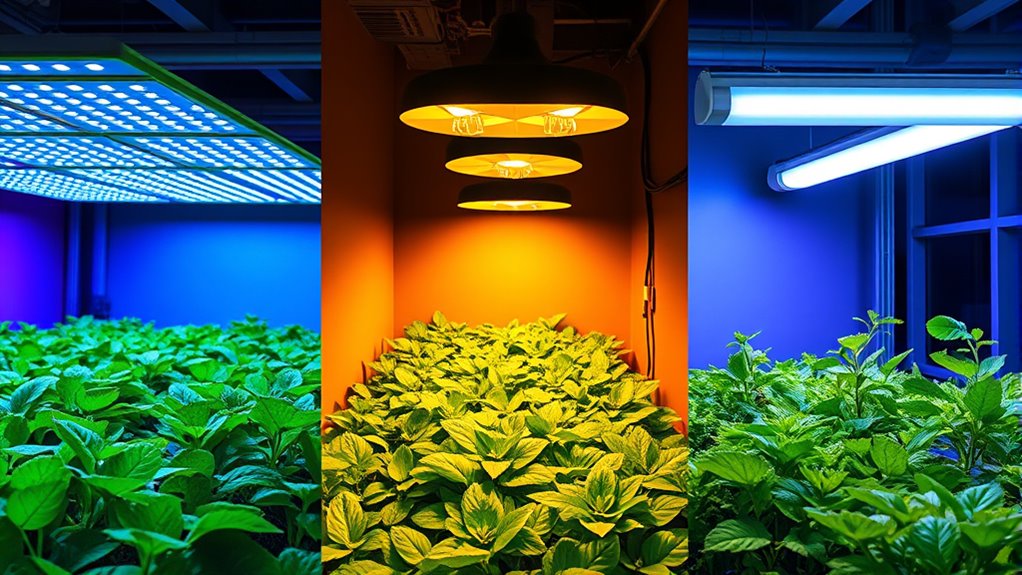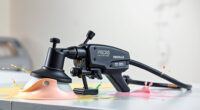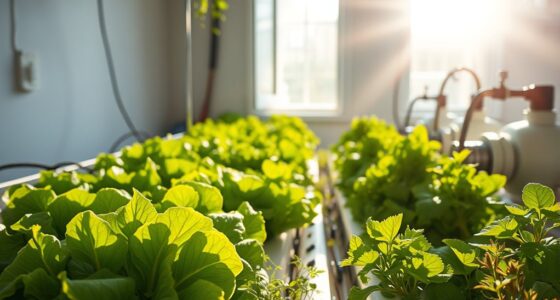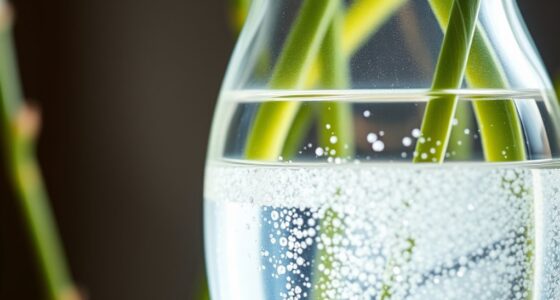When choosing between LED, HID, and fluorescent lighting for your indoor hydroponic farm, consider efficiency, cost, and plant stage needs. LEDs offer customizable spectra, high energy efficiency, and generate less heat, making them ideal for growing conditions. HID lights provide intense coverage suitable for larger farms, but they consume more energy and produce heat. Fluorescent lights are great for seedlings with low heat output but are less powerful overall. Explore each option to optimize your cultivation results.
Key Takeaways
- LEDs offer customizable spectra, high energy efficiency, and longer lifespan, making them ideal for precise stage-specific plant growth.
- HID lights provide intense, large-area coverage with suitable spectral options (MH and HPS) but consume more energy and generate more heat.
- Fluorescent lights are best for seedlings and clones due to their soft, diffuse light and low heat output but have limited intensity and lifespan.
- LEDs reduce cooling costs and infrastructure needs, while HID and fluorescent options may require additional cooling and installation considerations.
- Selecting the optimal lighting depends on growth stage, energy efficiency goals, and budget, with LEDs generally offering the most versatile innovation.
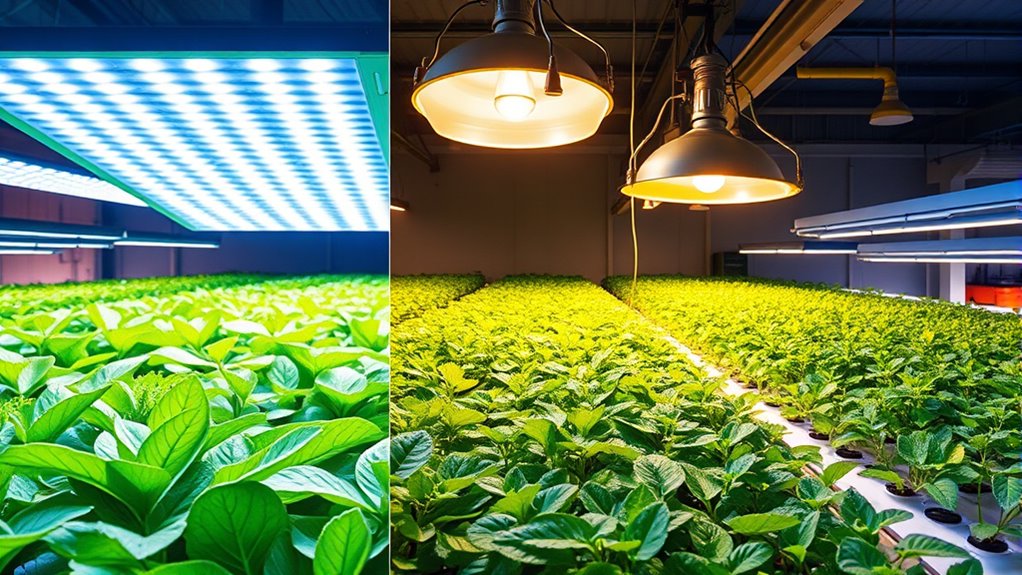
Hydroponic lighting is vital for growing healthy plants in a soil-free environment. Without proper illumination, your plants won’t develop their full potential, and your indoor farm’s productivity can suffer. When choosing lighting technology, it’s important to consider spectrum optimization to guarantee your plants receive the right wavelengths for photosynthesis and growth. Additionally, energy efficiency plays a significant role in keeping operational costs manageable and reducing your environmental impact. Whether you opt for LED, HID, or fluorescent lights, understanding their advantages helps you make informed decisions tailored to your specific needs.
Proper hydroponic lighting ensures healthy growth, boosts yield, and reduces costs through spectrum optimization and energy efficiency.
LED lights are rapidly becoming the top choice for hydroponic growers. They excel in spectrum optimization because they can be engineered to emit precise wavelengths that promote vegetative growth or flowering. This targeted approach not only enhances plant health but also maximizes yield. LEDs are highly energy-efficient, consuming less power compared to traditional lighting options, which translates into lower electricity bills. Their long lifespan further boosts cost savings over time, making them a sustainable investment. Plus, LEDs generate less heat, reducing the need for extensive cooling systems and allowing you to place lights closer to plants without risking heat stress.
HID lights, including Metal Halide (MH) and High-Pressure Sodium (HPS) lamps, have historically been the go-to for indoor farms. They produce intense light that covers large areas, making them suitable for commercial setups. MH lights offer a spectrum that’s beneficial during the vegetative stages, while HPS lights excel during flowering, thanks to their warmer spectral output. However, these lights are less energy-efficient than LEDs, consuming more power and generating significant heat, which can increase cooling costs. They also have shorter lifespans, requiring more frequent replacements. Despite these drawbacks, HIDs remain a reliable choice for growers who prioritize high-intensity lighting and have existing infrastructure.
Fluorescent lights, such as T5 tubes, provide a softer, more diffuse light source. They are often used for seedlings and clones because they emit less heat and have a broad spectrum that works well for early growth stages. While they are generally more energy-efficient than HID lights, they don’t match the efficiency or spectrum precision of LEDs. Fluorescent fixtures are affordable upfront and easy to install but tend to have shorter lifespans and less intensity, limiting their use to smaller-scale or specialized applications within your hydroponic system.
In making your decision, focus on spectrum optimization to ensure your plants get the right light for each growth stage. Prioritize energy efficiency not only to cut costs but also to minimize your carbon footprint. Whether you choose LEDs, HIDs, or fluorescents, understanding their strengths and limitations helps you create an optimized, sustainable environment that promotes healthy, vigorous plant growth.
Frequently Asked Questions
How Does Light Spectrum Affect Plant Growth in Hydroponics?
You might wonder how light spectrum impacts plant growth. The light spectrum, which includes different wavelengths, directly influences plant development by affecting photosynthesis and flowering. Blue light promotes vegetative growth, while red light enhances flowering and fruiting. By optimizing the light spectrum, you can boost plant health and yield in hydroponics. Understanding this allows you to choose the right lighting to support your plants’ specific growth stages effectively.
What Are the Energy Efficiency Differences Among LED, HID, and Fluorescent Lights?
You’ll find that LEDs are the most energy-efficient, consuming less energy for the same light output, which boosts your cost efficiency over time. HID lights use more energy and generate more heat, leading to higher utility costs. Fluorescent lights are moderate but less efficient than LEDs. Choosing LEDs can notably reduce energy consumption and operating costs, making them a smart choice for maximizing your indoor farm’s productivity and sustainability.
Can LED Grow Lights Be Used for All Plant Types?
You might wonder if LED grow lights can handle all plant types. The answer is yes, but with a twist. LEDs excel because of their plant adaptability and light customization options, allowing you to tailor the spectrum for different species. However, some plants might need specific wavelengths or intensities. So, while LEDs are versatile, understanding individual plant needs guarantees you get the best growth results.
How Does Light Intensity Impact Hydroponic Crop Yields?
You should know that light intensity directly impacts your hydroponic crop yields by maximizing light distribution for even coverage. Higher intensity promotes faster growth, but it also increases heat dissipation, which can stress plants if not managed properly. Too little light results in poor yields, while too much can cause overheating. Adjusting light intensity ensures your plants get the ideal energy they need for healthy, abundant growth.
What Are the Maintenance Requirements for Different Hydroponic Lighting Systems?
You need to follow proper maintenance for your hydroponic lighting systems. Keep a regular cleaning schedule to prevent dust and algae buildup that can reduce efficiency. For HID and fluorescent lights, plan for bulb replacements every 6-12 months, as their brightness diminishes over time. LEDs generally last longer but still require periodic cleaning of heat sinks. Staying on top of these tasks ensures maximum light delivery and healthy crop growth.
Conclusion
Think of your hydroponic farm as a thriving garden orchestra, where lighting is the conductor guiding growth. Whether you choose LED, HID, or fluorescent lights, each brings its unique melody to your plants’ development. By selecting the right lighting, you’re tuning your indoor farm for success. Remember, the right illumination is the spark that ignites your green symphony, turning your indoor space into a lush, vibrant oasis that flourishes under your careful guidance.

